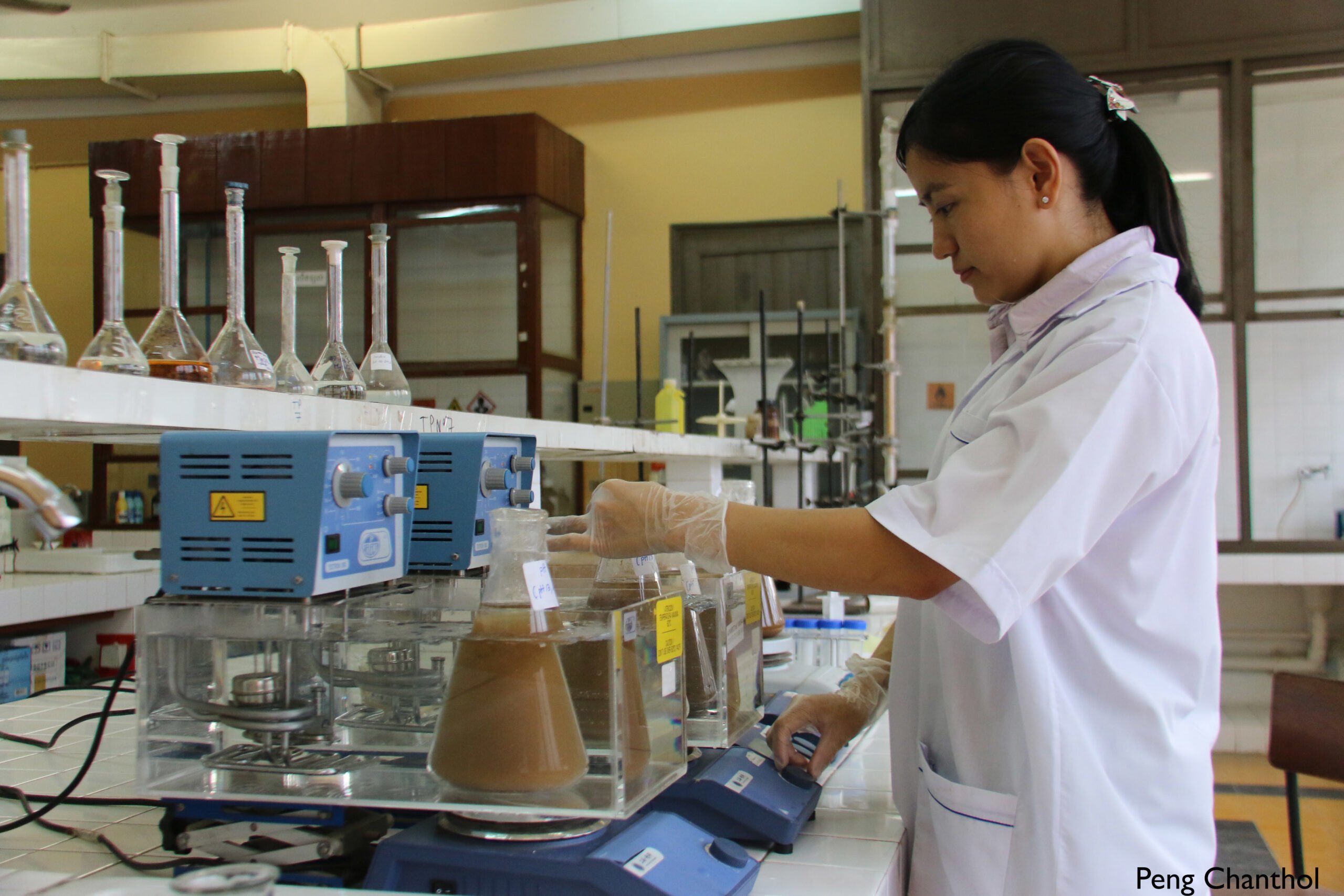
លោកស្រីបណ្ឌិត តាន់ រស្មី ជាអ្នកស្រាវជ្រាវ និងសាស្ត្រាចារ្យនៃនាយកដ្ឋានវិស្វកម្មគីមី និងបច្ចេកវិទ្យាចំណីអាហារ នៃវិទ្យាស្ថានបច្ចេកវិទ្យាកម្ពុជា។ រូបថតពី USAID Asia កាលពីថ្ងៃទី៥ ខែសីហា ឆ្នាំ២០១៦។ ក្រោមអាជ្ញារបណ្ណ CC BY-NC-SA 2.0
ក្របខ័ណ្ឌគោលនយោបាយជាតិដែលពាក់ព័ន្ធ
តាមទស្សនៈរបស់រដ្ឋាភិបាលទាំងមូល រដ្ឋាភិបាលកម្ពុជាបន្តលើកកម្ពស់សមភាពយេនឌ័រក្នុងប្រទេសតាមរយៈគំនិតផ្តួចផ្តើមផ្សេងៗ រួមមានយុទ្ធសាស្ត្រចតុកោណដំណាក់កាលទី៤ ២០១៩-២០២៣ ដែលពង្រីកកម្មវិធីអប់រំ និងបណ្តុះបណ្តាលវិជ្ជាជីវៈ ដើម្បីបង្កើនភាពជាសហគ្រិនស្ត្រី រួមជាមួយនឹងការលើកកម្ពស់សមភាពយេនឌ័រក្នុងការគាំពារសង្គម និងអាហារូបត្ថម្ភ។ លើសពីនេះទៅទៀត ការលើកកម្ពស់សមភាពយេនឌ័រនៅក្នុងបរិបទនៃការផ្លាស់ប្តូរឌីជីថលក្នុងការឆ្លើយតបទៅនឹងភាពមិនប្រាកដប្រជាជាសកល និរន្តរភាពបរិស្ថាន និងការប្រែប្រួលអាកាសធាតុ ត្រូវបានគូសបញ្ជាក់នៅក្នុងយុទ្ធសាស្ត្របញ្ចកោណដំណាក់កាលទី១។ គំនិតផ្តួចផ្តើមរបស់រដ្ឋាភិបាលផ្សេងទៀតរួមមាន ១)ក្របខ័ណ្ឌគោលនយោបាយជាតិស្តីពីសេដ្ឋកិច្ចឌីជីថល និងសង្គម ២០២១-២០៣៥ ដែលផ្តោតលើការចូលរួមរបស់ស្ត្រីក្នុងវិស័យឌីជីថល រួមជាមួយនឹងគោលនយោបាយរដ្ឋាភិបាលឌីជីថលកម្ពុជា ២០២២-២០៣៥ ក្នុងគោលបំណង “កាត់បន្ថយគម្លាតយេនឌ័រក្នុងជំនាញឌីជីថល” ២)យុទ្ធសាស្ត្រជាតិស្តីពីបរិយាបន្នហិរញ្ញវត្ថុ ២០១៩-២០២៥ ដើម្បីបង្កើនការឆ្លើយតបយេនឌ័រ ដែលលើកកម្ពស់សមភាពយេនឌ័រ និងការលើកកម្ពស់ស្ត្រីទាក់ទងនឹងបរិយាបន្នហិរញ្ញវត្ថុ និង ៣)ផែនការយុទ្ធសាស្ត្រប្រាំឆ្នាំស្តីពីសមភាពយេនឌ័រ និងការលើកកម្ពស់ស្ត្រី ២០១៩-២០២៣1 ដោយក្រសួងកិច្ចការនារី (MoWA) ដើម្បីលើកកម្ពស់ការឆ្លើយតបយេនឌ័រ និងបរិយាបន្នក្នុងក្របខ័ណ្ឌគោលនយោបាយជាតិ ផែនការយុទ្ធសាស្ត្រ និងកម្មវិធីជាតិទាក់ទងនឹងវិស័យសេដ្ឋកិច្ច។2
ទោះបីជាមានកិច្ចខិតខំប្រឹងប្រែងផ្សេងៗក៏ដោយ កម្ពុជាទទួលបានពិន្ទុត្រឹមតែ ០,៤៦១នៅលើសន្ទស្សន៍វិសមភាពយេនឌ័រ (GII) របស់កម្មវិធីអភិវឌ្ឍន៍អង្គការសហប្រជាជាតិ ដែលបង្ហាញឱ្យឃើញ ពីតម្រូវការសកម្មភាពបន្ថែមទៀត ដើម្បីសម្រេចបានសមភាពយេនឌ័រអោយបានប្រសើរជាងមុន។3
ការអប់រំ
យោងតាមទិន្នន័យធនាគារពិភពលោក អត្រាអក្ខរកម្មសម្រាប់មនុស្សពេញវ័យសំដៅលើ “ភាគរយនៃមនុស្សដែលមានអាយុចាប់ពី១៥ឆ្នាំឡើងទៅដែលទាំងអាចអាន និងសរសេរបានដោយមានការយល់ដឹងអំពី ប្រយោគសាមញ្ញខ្លីៗអំពីជីវិតប្រចាំថ្ងៃ”។ គិតត្រឹមឆ្នាំ២០២១ អត្រាអក្ខរកម្មស្ត្រីពេញវ័យនៅកម្ពុជាមាន ប្រហែល ៧៩,៨%ខណៈអត្រាអក្ខរកម្មបុរសពេញវ័យមានប្រហែល ៨៨,៤%។ ជាកាប្រៀបធៀប អត្រាអក្ខរកម្ម របស់ស្ត្រីពេញវ័យនៅអាស៊ីបូព៌ា និងប៉ាស៊ីហ្វិក មានប្រមាណ ៩៤,៥%។4
ក្រសួងអប់រំ យុវជន និងកីឡាកម្ពុជា បានរាយការណ៍ថា អត្រាចុះឈ្មោះចូលរៀនកម្រិតបឋមសិក្សាសម្រាប់សិស្សស្រីមានប្រមាណ ៩៥,៩% និងសិស្សប្រុសប្រមាណ ៩៥,៥% សម្រាប់ឆ្នាំសិក្សា២០២២-២០២៣។ អត្រាបញ្ចប់ការសិក្សានៅកម្រិតបឋមសិក្សាគឺប្រហែល៨៩,៤% សម្រាប់សិស្សស្រី និងប្រហែល ៨៥.៣%សម្រាប់សិស្សប្រុស។ នៅកម្រិតបឋមអត្រាបោះបង់ការសិក្សាសម្រាប់សិស្សស្រីគឺ ៩,៥%ខ្ពស់ជាងអត្រាសិស្សប្រុសដែលមានប្រមាណ ៥,៥%។5 តួនាទីនិងទំនៀមទម្លាប់ ការរៀបអាពាហ៍ពិពាហ៍មុនអាយុ ពលកម្មដោយបង្ខិតបង្ខំនិងការងារបំរើតាមផ្ទះ ការជួញដូរមនុស្ស និងអនាម័យ គឺជាឧបសគ្គចម្បងមួយចំនួន ដែលរារាំងក្មេងស្រីពីការទទួលបានការអប់រំ ឬបន្តការសិក្សា។6
នៅកម្រិតមធ្យមសិក្សាបឋមភូមិ សិស្សស្រីមានអត្រាចុះឈ្មោះចូលរៀនប្រហែល ៨៥,៩%និងមានអត្រាបញ្ចប់ការសិក្សាប្រហែល ៦០,៤%។ ចំពោះសិស្សប្រុស អត្រាចុះឈ្មោះចូលរៀនមានប្រហែល ៨១,៤%និងអត្រាបញ្ចប់ការសិក្សាមានប្រហែល ៥១%។ ការចុះឈ្មោះចូលរៀននៅកម្រិតមធ្យមសិក្សាទុតិយភូមិបានធ្លាក់ចុះទាំងសិស្សប្រុស និងសិស្សស្រី ដោយអត្រា ៤៦,១%សម្រាប់សិស្សស្រី និង ៣៦,៥%សម្រាប់សិស្សប្រុស។7
ប៉ុន្តែប្រសិនបើប្រៀបធៀបទៅនឹងអត្រាបោះបង់ការសិក្សាពីឆ្នាំ២០២០ ដល់ឆ្នាំ២០២១ មានភាពខុសប្លែកគ្នាដែលសិស្សប្រុសបានបោះបង់ការសិក្សាច្រើនជាងសិស្សស្រី ដោយប្រហែល ១៦,៩% នៃសិស្សស្រីនៅកម្រិតមធ្យមសិក្សាទុតិយភូមិបានបោះបង់ការសិក្សា ចំណែកអត្រានៃការបោះបង់ការសិក្សារបស់សិស្សប្រុសគឺលើសពី ១៩%។8 នោះក៏ព្រោះតែក្មេងប្រុសជំទង់ដែលមានអាយុពី១៤-១៨ឆ្នាំទទួលបាននូវតម្រូវការច្រើនពីនិយោជក ជាពិសេសក្នុងចំពោះការងារធ្ងន់ និងគ្មានជំនាញ ដែលទាមទារការធ្វើដំណើរ និងធ្វើការវេនយប់ច្រើន នេះបើយោងតាមតំណាងអង្គការយូណេស្កូកម្ពុជា។9
ទោះបីជាអត្រាចូលរៀននិងបញ្ចប់ការសិក្សារបស់សិស្សស្រីនៅបឋមសិក្សា មធ្យមសិក្សាបឋមភូមិ និងទុតិយភូមិ ខ្ពស់ជាងសិស្សប្រុស តែអត្រានៅថ្នាក់ឧត្តមសិក្សាមាននិន្នាការផ្ទុយពីនេះ។ សម្រាប់ឆ្នាំសិក្សា២០២១-២០២២ ក្នុងចំណោមសិស្សចំនួន ២០៦,៨៩៣នាក់ នៅក្នុងថ្នាក់ឧត្តមសិក្សាសិស្សស្រីមានតែ ៩៧.២៣៥នាក់ ឬ ៤៦%ប៉ុណ្ណោះ ដែលភាគច្រើនសិក្សាថ្នាក់បរិញ្ញាបត្រ។ សម្រាប់ថ្នាក់បរិញ្ញាបត្រជាន់ខ្ពស់ ឬថ្នាក់បណ្ឌិត ចំនួននិស្សិតស្រីធ្លាក់ចុះយ៉ាងខ្លាំង។ សម្រាប់ឆ្នាំ២០២១-២០២២ ក្នុងចំណោមសិស្ស ៩.៤៨៣នាក់ដែលកំពុងបន្តបរិញ្ញាបត្រជាន់ខ្ពស់ មានត្រឹមតែ ២.៧១៨នាក់ ឬ ២៨,៦% ប៉ុណ្ណោះជាសិស្សស្រី។ គម្លាតនេះកាន់តែធំសម្រាប់ថ្នាក់បណ្ឌិត ព្រោះមានតែប្រមាណ ១១៦នាក់ក្នុងចំណោម ១.២១៣នាក់ ឬ ៩,៥%ជាសិស្សស្រី។10
ការងារ
ស្ត្រីគឺជាអ្នករួមចំណែកដ៏សំខាន់ដល់សេដ្ឋកិច្ចរបស់កម្ពុជា។ យោងតាមធនាគារពិភពលោកស្ទើរតែពាក់កណ្តាលនៃកម្លាំងពលកម្មសរុបក្នុងប្រទេសកម្ពុជាជាស្ត្រី ដែលស្មើនឹង ៤៧,១%នៃកម្លាំងពលកម្មសរុបក្នុងឆ្នាំ២០២២។11 យោងតាមរបាយការណ៍សង្កេតសេដ្ឋកិច្ចសង្គមកិច្ចរបស់កម្ពុជា អត្រាចូលរួមក្នុងកម្លាំងពលកម្មស្ត្រីក្នុងឆ្នាំ២០២១ ត្រូវបានគេរាយការណ៍ថាមានប្រហែល ៤៨,៨%នៃអត្រាចូលរួមកម្លាំងពលកម្មសរុបនៅក្នុងប្រទេស។12
យោងតាមវិទ្យាស្ថានជាតិស្ថិតិអត្រាការងារក្នុងឆ្នាំ២០២១ គឺប្រហែល ៧៩%សម្រាប់ស្ត្រី និង ៨៩%សម្រាប់បុរសដែលភាពខុសគ្នារវាងបុរសនិងស្ត្រីមានជាង ១០%។នៅក្នុងឆ្នាំដដែល អត្រាគ្មានការងារធ្វើ មានប្រហែល០,៩%សម្រាប់បុរស និងប្រហែល ១,២%សម្រាប់ស្ត្រី ខណៈអត្រាគ្មានការងារធ្វើ ជាមធ្យមក្នុងឆ្នាំ២០២១ មានប្រហែល ១%។13 នៅឆ្នាំ២០២៣ អត្រាអ្នកគ្មានការងារធ្វើនៅកម្ពុជា ត្រូវបានព្យាករណ៍ថានឹងមាននិន្នាការក្នុងរង្វង់២% និង ០,៩% នៅឆ្នាំ២០២៤ នេះបើយោងតាមការព្យាករណ៍នៃគំរូសេដ្ឋកិច្ច។14
វិទ្យាស្ថានជាតិស្ថិតិកម្ពុជាបានកំណត់និយមន័យដល់បុគ្គលិកគណនីផ្ទាល់ខ្លួនឬបុគ្គលស្វ័យនិយោជន៍ថាជា “បុគ្គលដែលធ្វើការក្នុងរយៈពេល ៧ ថ្ងៃចុងក្រោយនេះ ដើម្បីចិញ្ចឹមគ្រួសារនិងដែលគ្រប់គ្រងសហគ្រាសផ្ទាល់ខ្លួន (ឧទាហរណ៍ កសិករដាំដុះដីផ្ទាល់ខ្លួន ម្ចាស់ហាងតូចៗ ឬ ភោជនីយដ្ឋានតូចៗ) ដោយគ្មានការទូទាត់ឬប្រាក់ចំណូលគ្រប់ប្រភេទ”។ យោងតាមការស្ទង់មតិសេដ្ឋកិច្ចសង្គមកិច្ចកម្ពុជាឆ្នាំ២០២១ ការងារសម្រាប់ស្ត្រីរួមមាននិយោជិតមានប្រាក់ឈ្នួល (៤០,៦%) និយោជក (០,២%) បុគ្គលិកគណនីផ្ទាល់ខ្លួន/បុគ្គលស្វ័យនិយោជន៍ (៣៨,៤%) និងកម្មករគ្រួសារដែលមិនទទួលបានប្រាក់ខែ (២០,៩%)។ ស្ត្រីប្រហែល ៩០៥ពាន់នាក់ ធ្វើការជាកម្មករគ្រួសារដែលមិនមានប្រាក់ខែ ដោយតួលេខនេះច្រើនជាងបុរសជិត ២ ដងក្នុងស្ថានភាពការងារដូចគ្នា ដោយបុរសមានជាង ៤៤៩ពាន់នាក់។15
គិតត្រឹមឆ្នាំ២០២១ ប្រហែល ៣៨,៣%នៃកម្លាំងពលកម្មស្ត្រីសរុប ធ្វើការនៅក្នុងវិស័យកសិកម្ម ប្រហែល ៣៧,៥%ធ្វើការ ក្នុងវិស័យសេវាកម្ម និងប្រហែល ២៤,៣%ធ្វើការក្នុងវិស័យឧស្សាហកម្ម។ ក្នុងចំណោមស្ត្រីប្រហែល ៤.៣៣៩ពាន់នាក់ដែលធ្វើការនៅឆ្នាំ២០២១ តិចជាង ១%នៃស្ត្រីដែលមានការងារធ្វើ ឬប្រហែល ២៧ពាន់នាក់ ធ្វើការក្នុងមុខតំណែងអ្នកគ្រប់គ្រង ផ្ទុយពីតួរលេខ ១,៣%ឬ ៥៩ពាន់នាក់ សម្រាប់បុរស។ ស្ត្រីប្រហែល ១,៤៤៤ពាន់នាក់ធ្វើការជា "កម្មករជំនាញកសិកម្ម ព្រៃឈើ និងនេសាទ" ១,១១៧ពាន់នាក់ ជា"បុគ្គលិកផ្នែកលក់ និងសេវាកម្ម" និង ៩២១ពាន់នាក់ជា"កម្មករសិប្បកម្ម និងពាក់ព័ន្ធ"។16
ស្ត្រីភាគច្រើនដែលធ្វើការក្នុងវិស័យឧស្សាហកម្ម ធ្វើការផ្នែកកាត់ដេរ ដោយសារតែវិស័យកាត់ដេរ គឺជាវិស័យដ៏ធំបំផុតមួយ និងជាក្បាលម៉ាស៊ីនដ៏សំខាន់ចំពោះកំណើនសេដ្ឋកិច្ចរបស់កម្ពុជា។17 មុនកូវីដ-១៩ រាតត្បាត វិស័យកាត់ដេរមានបុគ្គលិកប្រមាណ ៩០ម៉ឺននាក់ ក្នុងនោះប្រហែល ៨០%ជាស្ត្រី។18
សេដ្ឋកិច្ច
យោងតាមរបាយការណ៍ឆ្នាំ២០២១ របស់កម្មវិធីអភិវឌ្ឍន៍អង្គការសហប្រជាជាតិ (UNDP) គម្លាតប្រាក់ឈ្នួលយេនឌ័រនៅតែមានទំហំធំរវាងបុរស និងស្ត្រីនៅក្នុងប្រទេសកម្ពុជា លើគ្រប់វិស័យឧស្សាហកម្ម និងមុខរបរនានា។ ការសិក្សាមួយក្នុងឆ្នាំ២០១៩ បានរកឃើញថា ស្ត្រីកម្ពុជារកបានប្រហែល ៨០%នៃប្រាក់ឈ្នួលដែលបុរសរកបាន ខណៈដែលស្ត្រីមានទ្រព្យសម្បត្តិតិចជាងបុរស និងប្រឈមមុខនឹងឧបសគ្គច្រើនទៅលើឱកាសការងារដែលមានប្រាក់ខែល្អ។ គម្លាតប្រាក់ឈ្នួលនេះកាន់តែធំចំពោះការងារ ដែលមានប្រាក់ខែខ្ពស់ដោយស្ត្រីទទួលបានប្រាក់ឈ្នួលតិចជាងបុរស។ ក្នុងឆ្នាំ២០១៧ គម្លាតប្រាក់ឈ្នួល យេនឌ័រនៅក្នុងប្រទេសកម្ពុជាគឺប្រហែល ២៤%មុននឹងថយចុះមកនៅត្រឹម១៩% ក្នុងឆ្នាំ២០២០។ កត្តារួមចំណែកដ៏សំខាន់ចំពោះគម្លាតប្រាក់ឈ្នួលនេះ ត្រូវបានសន្មតថាជាការរើសអើងយេនឌ័រនេះ បើយោងតាម ទិន្នន័យរបស់ CSES សម្រាប់ឆ្នាំ២០១៩-២០២០។19
បញ្ហាប្រឈមសំខាន់ៗ
បន្ថែមពីលើគម្លាតប្រាក់ឈ្នួលយេនឌ័រសម្រាប់ការងារដូចគ្នាស្ត្រីក៏ប្រឈមមុខនឹងបញ្ហាប្រឈមដទៃទៀតរួមមានភាពងាយរងគ្រោះក្នុងអំពើជួញដូរមនុស្ស គម្លាតជំនាញ កង្វះការគាំទ្រដល់សហគ្រិនភាព និងកង្វះតំណាងក្នុងមុខតំណែងជាន់ខ្ពស់។
យោងតាមការសិក្សារបស់ UN Women ដែលមានចំណងជើងថា "ថាមវន្តយេនឌ័រក្នុងការជួញដូរមនុស្សនៅប្រទេសកម្ពុជា មីយ៉ាន់ម៉ា និងថៃ" ប្រទេសកម្ពុជាត្រូវបានកំណត់ថាជា ប្រទេសដើម គោលដៅ និងចំណតនៃជនរងគ្រោះពីការជួញដូរមនុស្ស។ ប្រទេសថៃជាប្រទេសគោលដៅសំខាន់សម្រាប់ជនរងគ្រោះដែលត្រូវបានគេជួញដូរពីប្រទេសកម្ពុជា។ ជារៀងរាល់ឆ្នាំគេប៉ាន់ប្រមាណថាជនចំណាកស្រុកកម្ពុជាប្រមាណ ៥៥ពាន់នាក់ត្រូវបាននាំទៅកាន់ប្រទេសថៃដោយខុសច្បាប់ ហើយចន្លោះពី ៤% ទៅ ២៣% នៃជនចំណាកស្រុកទាំងនោះអាចជាជនរងគ្រោះនៃការជួញដូរ។ ការសិក្សាបានគូសបញ្ជាក់បន្ថែមថា “ទំនួលខុសត្រូវដែលដាក់លើស្ត្រីដើម្បីបំពេញតម្រូវការថែទាំគ្រួសាររបស់ពួកគេផ្សំជាមួយការរំពឹងទុកថាពួកគេនឹងផ្តល់ប្រាក់ចំណូល។ កត្តានេះ រួមជាមួយភាពមានកម្រិតនៃឱកាសការងារ ដោយសារការបែងចែកយេនឌ័រ ក្នុងទីផ្សារការងារក្នុងស្រុក នាំឱ្យស្ត្រីនិងកុមារីក្រីក្រជាច្រើននាក់ស្វែងរកការធ្វើចំណាកស្រុក ដែលបង្កើនហានិភ័យនៃការជួញដូរមនុស្ស។"20
ដើម្បីប្រយុទ្ធប្រឆាំងនឹងការជួញដូរមនុស្ស កម្ពុជាបានផ្តល់សច្ចាប័នលើច្បាប់និងសន្ធិសញ្ញាអន្តរជាតិផ្សេងៗ រួមមានអនុសញ្ញាអង្គការសហប្រជាជាតិស្តីពីសិទ្ធិកុមារ អនុសញ្ញាស្តីពីពលកម្មដោយបង្ខំ របស់អង្គការពលកម្មអន្តរជាតិ២៩ និង១០៥ អនុសញ្ញាស្តីពីទម្រង់អាក្រក់បំផុតនៃពលកម្មកុមាររបស់អង្គការ ពលកម្មអន្តរជាតិ និងអនុសញ្ញាអាស៊ានប្រឆាំងការជួញដូរមនុស្ស ជាពិសេសស្ត្រីនិងកុមារ។21,22
ទោះជាយ៉ាងណា ស្ត្រីកម្ពុជានៅតែប្រឈមមុខនឹងបញ្ហាមួយចំនួនទាក់ទងនឹងការការពារជនរងគ្រោះនិងការដាក់ទោស នេះបើយោងតាមការសិក្សាមួយ23 ដែលនិយាយថា "តុលាការ និងតួអង្គយុត្តិធម៌នៅកម្ពុជាមិនមានសមភាពយេនឌ័រ"។ លើសពីនេះ «ការពពោះជំនួសដោយបង្ខំ» នៅតែជាបញ្ហាជាប់គាំងសម្រាប់ស្ត្រីកម្ពុជា ដែលជាជនរងគ្រោះនៃការជួញដូរមនុស្ស ដោយសារច្បាប់ការងារ និងច្បាប់ព្រហ្មទណ្ឌមិនទាន់មានប្រសិទ្ធភាពក្នុងការដោះស្រាយបញ្ហានេះ។ ករណីស្ត្រីក្នុងការជួញដូរមនុស្សនេះក៏ឆ្លុះបញ្ចាំងនូវរបាយការណ៍ភស្តុតាងមួយទៀតដោយអ្នកឃ្លាំមើលក្នុងស្រុកដែលរកឃើញថា “ស្ត្រីកម្ពុជាបន្តប្រឈមមុខនឹងបញ្ហាក្នុងការទទួលបានយុត្តិធម៌ ហើយស្ត្រីចុងចោទមិនសូវទទួលបានការគោរព ចំពោះសិទ្ធិនៃការកាត់ក្តីដោយយុត្តិធម៌។ លើសពីនេះ ប្រព័ន្ធយុត្តិធម៌កម្ពុជាដែលស្ត្រីមានចំនួនតិចស្រាប់ ហាក់មានកង្វះសមភាពយេនឌ័រដែលរារាំងទាំងស្ត្រីរងគ្រោះនិងចុងចោទពីការទទួលបានយុត្តិធម៌គ្រប់គ្រាន់។ នៅឆ្នាំ២០២០ មានតែចៅក្រម១៥% ព្រះរាជអាជ្ញា១៤% និងមេធាវី២២% ប៉ុណ្ណោះជាស្ត្រីនៅកម្ពុជា"។24
នៅប្រទេសកម្ពុជា ច្បាប់ស្តីពីការបង្ក្រាបអំពើជួញដូរមនុស្សនិងអំពើធ្វើអាជីវកម្មផ្លូវភេទឆ្នាំ២០០៨ គឺជាច្បាប់ក្នុងស្រុកចម្បងដែលគ្រប់គ្រងលើបញ្ហានៃការជួញដូរមនុស្ស។25 រដ្ឋាភិបាលកម្ពុជាក៏បានបង្កើតគណៈកម្មាធិការជាតិប្រឆាំងការជួញដូរមនុស្ស (NCCT) ក្នុងឆ្នាំ២០១៤ ជាយន្តការថ្នាក់ជាតិ ដើម្បីលើកកម្ពស់ការអនុវត្តច្បាប់ និងគោលនយោបាយជាតិ និងអន្តរជាតិ ពាក់ព័ន្ធនឹងការប្រយុទ្ធប្រឆាំងការជួញដូរមនុស្ស។26
ដូចដែលបានរៀបរាប់ខាងលើ ស្ត្រីវ័យក្មេងនៅក្នុងប្រទេសកម្ពុជាមិនសូវបន្តការសិក្សារបស់ពួកគេទេ ដោយសារកត្តាផ្សេងៗដែលធ្វើឱ្យពួកគេខ្វះជំនាញចាំបាច់ ដើម្បីស្វែងរកការងារដែលមានប្រាក់ខែប្រសើរជាងមុននិងការងារនៅក្នុងវិស័យសេដ្ឋកិច្ចផ្លូវការ។ ដើម្បីឆ្លើយតបនឹងបញ្ហានេះ រដ្ឋាភិបាលបាននិងកំពុងផ្តល់អាទិភាពដល់ការអប់រំវិជ្ជាជីវៈតាមរយៈគំនិតផ្តួចផ្តើមផ្សេងៗ ដើម្បីបង្រួមគម្លាតជំនាញក្នុងកម្លាំងពលកម្ម។27
កង្វះការគាំទ្រដល់ស្ត្រីក្នុងការក្លាយជាសហគ្រិននៅតែជាឧបសគ្គដល់ការលើកកម្ពស់ស្ត្រី។ សមាគមសហគ្រិនស្ត្រីកម្ពុជា (CWEA) រកឃើញបញ្ហាប្រឈមធំៗចំនួនបីសម្រាប់សហគ្រិនស្ត្រី រួមមាន ១)កង្វះលទ្ធភាពទទួលបានការអប់រំ ការបណ្តុះបណ្តាលជំនាញអាជីវកម្មនិងព័ត៌មាន ២)លទ្ធភាពទទួលបានហិរញ្ញវត្ថុ និង៣)ការចូលទៅកាន់ទីផ្សារ។ ដោយសាកលវិទ្យាល័យ និងស្ថាប័នបណ្តុះបណ្តាលភាគច្រើនផ្តោតលើស្ត្រីវ័យក្មេង និងស្ត្រីនៅលីវ សហគ្រិនស្ត្រីដែលត្រូវប្រកបអាជីវកម្មនិងបំពេញកាតព្វកិច្ចគ្រួសារ មិនសូវទទួលបានជំនួយនិងការយោគយល់ពីសាកលវិទ្យាល័យ និងស្ថាប័នបណ្តុះបណ្តាលនោះទេ។ កង្វះលទ្ធភាពក្នុងការទទួលបានចំណេះដឹងនិងជំនាញអាជីវកម្មបានផ្តល់ផលវិបាកដល់ស្ត្រីក្នុងការពង្រីកអាជីវកម្មនិងរកប្រាក់ចំណេញ។28 ដើម្បីឆ្លើយតបនឹងបញ្ហានេះ ក្រសួងកិច្ចការនារីបានបង្កើតមជ្ឈមណ្ឌលអភិវឌ្ឍន៍សហគ្រិនស្ត្រី(WEDC) និងបានផ្តួចផ្តើមបង្កើតបណ្តាញសហគ្រិនស្ត្រីជាតិកម្ពុជា (CamWEN) លើកដំបូងក្នុងឆ្នាំ២០២០ ដើម្បីគាំទ្រសហគ្រិនស្ត្រីនៅកម្ពុជា។29
ទោះបីជាប្រទេសកម្ពុជាបានចុះហត្ថលេខា និងផ្តល់សច្ចាប័នលើអនុសញ្ញាស្តីពីការលុបបំបាត់រាល់ទម្រង់នៃការរើសអើងប្រឆាំងនឹងស្ត្រី(CEDAW) តាំងពីឆ្នាំ១៩៩២ ក៏ដោយក៏ការចូលរួមរបស់ស្ត្រីនៅក្នុងសភានៅមានតិចតួចនៅឡើយ បើប្រៀបធៀបទៅនឹងបុរស។30 បញ្ហាប្រឈមសម្រាប់ស្ត្រីក្នុង មុខតំណែងជាអ្នកដឹកនាំបណ្តាលមកពី កត្តាសង្គម ស្ថាប័ន និងនយោបាយ ដែលបង្កើតឧបសគ្គនិងបន្តការរើសអើងផ្អែកតាមយេនឌ័រ។
ដើម្បីលើកកម្ពស់សមភាពយេនឌ័រ និងលើកទឹកចិត្តឱ្យមានការចូលរួមរបស់ស្ត្រី ក្នុងការធ្វើសេចក្តីសម្រេច រដ្ឋាភិបាលបានបង្កើតផែនការយុទ្ធសាស្ត្ររយៈពេលប្រាំឆ្នាំ (២០១៩-២០២៣) សម្រាប់សមភាពយេនឌ័រ និងការលើកម្ពស់ស្ត្រីនៅកម្ពុជា។ ផ្នែកមួយនៃផែនការយុទ្ធសាស្ត្រគឺ ធ្វើឱ្យប្រសើរឡើងនូវតុល្យភាពយេនឌ័រ ដោយការបង្កើនសមាមាត្រនៃស្ត្រីនៅក្នុងមុខតំណែងការងារ ស៊ីវិល/នយោបាយ និងការផ្តល់នូវភាពជាអ្នកដឹកនាំនិងការបណ្តុះបណ្តាលកសាងសមត្ថភាពសម្រាប់ស្ត្រី។31
ទាក់ទងនឹងស្ត្រីក្នុងការអភិវឌ្ឍ
ឯកសារយោង
- 1. ក្រសួងកិច្ចការនារី, “នារីរតនៈ ៥៖ ផែនការយុទ្ធសាស្ត្រប្រាំឆ្នាំសម្រាប់ការពង្រឹងការបញ្ជ្រាបយេនឌ័រ និងការពង្រឹងសិទ្ធិអំណាចរបស់ស្ត្រី,” ឆ្នាំ២០២១, បានចូលអាននៅខែសីហា ឆ្នាំ២០២៣។
- 2. UN Women, “របាយការណ៍វឌ្ឍនភាពកម្ពុជា,” ឆ្នាំ២០២២, បានចូលអាននៅខែសីហា ឆ្នាំ២០២៣។
- 3. កម្មវិធីអភិវឌ្ឍន៍អង្គការសហប្រជាជាតិ, “សន្ទស្សន៍វិសមភាពយេនឌ័រ,” របាយការណ៍អភិវឌ្ឍន៍មនុស្ស, អង្គការសហប្រជាជាតិ, បានចូលអាននៅខែសីហា ឆ្នាំ២០២៣។
- 4. ធនាគារពិភពលោក, “កម្ពុជា,” ទិន្នន័យយេនឌ័ររបស់ធនាគារពិភពលោក, បានចូលអាននៅខែសីហា ឆ្នាំ២០២៣។
- 5. ក្រសួងអប់រំ យុវជន និងកីឡា, "សន្និបាតអប់រំ," ឆ្នាំ២០២៣, បានចូលអាននៅខែសីហា ឆ្នាំ២០២៣។
- 6. Eugenie, "ហេតុអ្វីបានជាក្មេងស្រីមិននៅសាលា?," Children of the Mekong, ឆ្នាំ២០២១, បានចូលអាននៅខែសីហា ឆ្នាំ២០២៣។
- 7. ក្រសួងអប់រំ យុវជន និងកីឡា, "សន្និបាតអប់រំ," ឆ្នាំ២០២៣, បានចូលអាននៅខែសីហា ឆ្នាំ២០២៣។
- 8. ដូចឯកសារយោងខាងដើម។
- 9. Ngay Nai, "ក្មេងប្រុសកាន់តែច្រើនមានហានិភ័យក្នុងការបោះបង់ការសិក្សានៅកម្រិតមធ្យមសិក្សា," ខេមបូចា, ឆ្នាំ២០២២, បានចូលអាននៅខែសីហា ឆ្នាំ២០២៣។
- 10. ក្រសួងអប់រំ យុវជន និងកីឡា, "សន្និបាតអប់រំ," ឆ្នាំ២០២៣, បានចូលអាននៅខែសីហា ឆ្នាំ២០២៣។
- 11. ធនាគារពិភពលោក, "កម្លាំងពលកម្មស្ត្រី," ទិន្នន័យធនាគារពិភពលោក, បានចូលអាននៅខែសីហា ឆ្នាំ២០២៣។
- 12. វិទ្យាស្ថានជាតិស្ថិតិ, "របាយការណ៍សង្កេតសេដ្ឋកិច្ចសង្គមកិច្ចរបស់កម្ពុជាឆ្នាំ ២០២១," ឆ្នាំ២០២១, បានចូលអាននៅខែសីហា ឆ្នាំ២០២៣។
- 13. ដូចឯកសារយោងខាងដើម។
- 14. Prakash Jha, "ភាពអត់ការងារធ្វើនៅកម្ពុជានឹងនៅប្រហែល ២% ក្នុងឆ្នាំ២០២៣," ខ្មែរថាមស៍, ថ្ងៃទី១៧ ខែតុលា ឆ្នាំ២០២២, បានចូលអាននៅខែសីហា ឆ្នាំ២០២៣។
- 15. វិទ្យាស្ថានជាតិស្ថិតិ, "របាយការណ៍សង្កេតសេដ្ឋកិច្ចសង្គមកិច្ចរបស់កម្ពុជាឆ្នាំ ២០២១," ឆ្នាំ២០២១, បានចូលអាននៅខែសីហា ឆ្នាំ២០២៣។
- 16. ដូចឯកសារយោងខាងដើម។
- 17. ដូចឯកសារយោងខាងដើម។
- 18. កម្មវិធីអភិវឌ្ឍន៍អង្គការសហប្រជាជាតិ, "កំណត់សម្គាល់ព័ត៌មានទី៧៖ ការគាំទ្ររបស់អង្គការសហប្រជាជាតិកម្ពុជាចំពោះកម្មករកាត់ដេរក្នុងការឆ្លើយតបនឹងជំងឺកូវីដ១៩," ឆ្នាំ២០២១, បានចូលអាននៅខែសីហា ឆ្នាំ២០២៣។
- 19. កម្មវិធីអភិវឌ្ឍន៍អង្គការសហប្រជាជាតិ, "គម្លាតប្រាក់ឈ្នួលយេនឌ័រនៅកម្ពុជា," ២០២១, បានចូលអាននៅខែសីហា ឆ្នាំ២០២៣។
- 20. Abigail Hunt, Maria Quattri, Briana Mawby, Georgia Plank, Shan-non Phillip, Sokchar Mom, Khin Zar Naing, and Sanda Thant, "ថាមវន្តយេនឌ័រក្នុងការជួញដូរមនុស្សនៅប្រទេសកម្ពុជា មីយ៉ាន់ម៉ា និងថៃ," UN Women - អាស៊ីប៉ាស៊ីហ្វិក, ឆ្នាំ២០២០, បានចូលអាននៅខែសីហា ឆ្នាំ២០២៣។
- 21. ក្រសួងការបរទេស និងសហប្រតិបត្តិការអន្តរជាតិ, "ឧបករណ៍នៃការអនុម័ត," ឆ្នាំ២០១៦, បានចូលអាននៅខែសីហា ឆ្នាំ២០២៣។
- 22. UN Women - អាស៊ីប៉ាស៊ីហ្វិក, ឆ្នាំ២០២០, បានចូលអាននៅខែសីហា ឆ្នាំ២០២៣។
- 23. Rapid Asia, "ការការពារជនរងគ្រោះពីការជួញដូរមនុស្សនៅអាស៊ាន," ឆ្នាំ២០២៣, បានចូលអាននៅខែសីហា ឆ្នាំ២០២៣។
- 24. មជ្ឈមណ្ឌលសិទ្ធិមនុស្សកម្ពុជា, "មជ្ឈមណ្ឌលសិទ្ធិមនុស្សកម្ពុជា," ឆ្នាំ២០២២, បានចូលអាននៅខែសីហា ឆ្នាំ២០២៣។
- 25. Rapid Asia, "ការការពារជនរងគ្រោះពីការជួញដូរមនុស្សនៅអាស៊ាន," ឆ្នាំ២០២៣, បានចូលអាននៅខែសីហា ឆ្នាំ២០២៣។
- 26. គ.ជ.ប.ជ, "គណៈកម្មាធិការជាតិប្រយុទ្ធប្រឆាំងអំពើជួញដូរមនុស្ស," បានចូលអាននៅខែសីហា ឆ្នាំ២០២៣។
- 27. អូឌីស៊ី, "ការបណ្តុះបណ្តាលវិជ្ជាជីវៈ," ថ្ងៃទី១៣ ខែមករា ឆ្នាំ២០២២, បានចូលអាននៅខែសីហា ឆ្នាំ២០២៣។
- 28. សមាគមសហគ្រិនស្ត្រីកម្ពុជា, "ការលើកកម្ពស់លទ្ធភាពទទួលបានការអប់រំ និងព័ត៌មានសម្រាប់សហគ្រិនស្ត្រីនៅកម្ពុជា," សមាគមសហគ្រិនស្ត្រីកម្ពុជា, ២០២០, បានចូលអាននៅខែសីហា ឆ្នាំ២០២៣។
- 29. UN Women, "របាយការណ៍វឌ្ឍនភាពកម្ពុជា," ឆ្នាំ២០២២, បានចូលអាននៅខែសីហា ឆ្នាំ២០២៣។
- 30. ចាន់លីនដា មិត្ត, សុធារី មាច, លក្ខិណា ចាន់, រ័ត្ន វត្តីសុវណ្ណ, ខេមរិន ខៀវ, និង សុវណ្ណា សួន, "បញ្ហាប្រឈមរបស់ស្ត្រីក្នុងភាពជាអ្នកដឹកនាំ៖ ការរកឃើញសំខាន់ៗពីការវិភាគស្ថិតិយេនឌ័រ," ឆ្នាំ២០២០, បានចូលអាននៅខែសីហា ឆ្នាំ២០២៣។
- 31. ក្រសួងកិច្ចការនារី, "នារីរតនៈ ៥៖ ផែនការយុទ្ធសាស្រ្តប្រាំឆ្នាំសម្រាប់ការពង្រឹងការបញ្ជ្រាបយេនឌ័រ និងការលើកកម្ពស់ស្ត្រី," ក្រសួងកិច្ចការនារី, ២០២១, បានចូលអាននៅខែសីហា ឆ្នាំ២០២៣។

